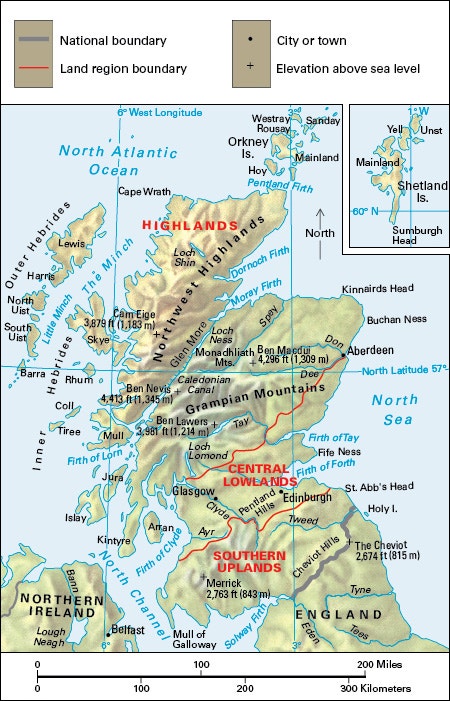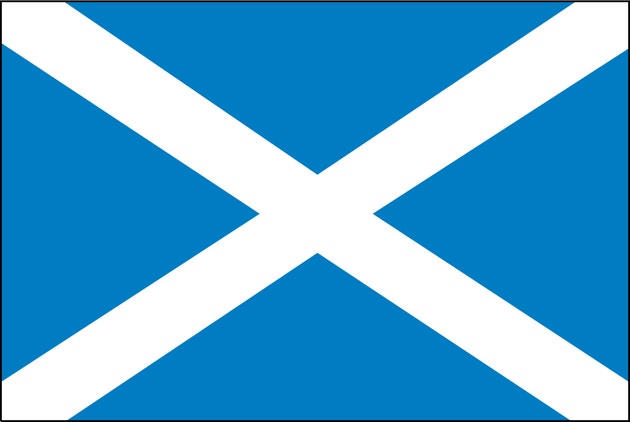
Citation (1)

Citation (2)

Capital: Edinburgh
Official language: English
Population: Current estimate—5,484,000; density, 182 per mi2 (70 per km2); distribution, 86 percent urban, 14 percent rural. 2011 census—5,295,403
Flag: Scotland's flag has a white X on a blue background. The flag is called St. Andrew's Cross. It has never been officially adopted, but the Scottish people have flown it for hundreds of years.
Chief products: Agriculture—barley, cattle, milk, sheep, wheat. Fishing—cod, crabs, haddock, mackerel, scallops. Manufacturing—chemicals, electronic equipment, food and beverages, and metal products. Mining—petroleum.
Citation (3)
Traditional music in Scotland is unusual among European folk traditions in that there is a long history of mixed oral and literate transmission of melodies, tunes and songs, and in that much of what is accepted as folk music in Scotland is of known authorship. Traditional music may be heard at a variety of events ranging from the most intimate and informal to the most highly organized and public. Traditional music also forms an essential part of a lively group of dance traditions in Scotland. A standard ensemble of accordion(s), fiddle, piano, bass and drums developed in the mid-20th century to accompany Scottish country dancing. The traditional Céilidh is the most important informal context for music-making. Although rooted in Gaelic culture, céilidhs can be found at homes throughout Scotland, including travellers’ camp sites. Prominent musical characteristics found in the traditional music of Scotland include pentatonic modes, double-tonic tunes, cyclical melodies, and the Scotch snap.
Citation (6)
Citation (5)
Labour song associated with the finishing or waulking of handwoven tweed in Gaelic areas of Scotland. Tweed waulking was traditionally a communal activity of women, who sang the songs, alternating between a soloist and chorus, to coordinate their physical efforts and to relieve the monotony of their work.
Citation (4)
Burns was a poet and songwriter. He had little formal education, first at a local school, then from his father, but his appetite for wide reading, and his intense interest in and love for the Scottish countryside and the oral literature and music of its people, gave him an enviable command over two languages, English and Scots, and a deep appreciation of the wide range of sentiment expressed in Scots traditional melody.
Citation: Cooke, P. (2001). Burns, Robert. Grove Music Online. Retrieved 4 Nov. 2020, from https://www.oxfordmusiconline.com/grovemusic/view/10.1093/gmo/9781561592630.001.0001/omo-9781561592630-e-0000004402.
(1): "Scotland" by Sean McGrath CC-BY 2.0
(2): Scotland cities [Online map]. (2020). In World Book Advanced. Retrieved from
https://www.worldbookonline.com/advanced/media?id=mp001114
(3): Turnock, D. (2021). Scotland. In World Book Advanced. https://www.worldbookonline.com/advanced/article?id=ar496520
(4): (2001). Waulking song. Grove Music Online. Retrieved 4 Nov. 2020, from https://www.oxfordmusiconline.com/grovemusic/view/10.1093/gmo/9781561592630.001.0001/omo-9781561592630-e-0000029956.
(5): Glorious Scotland: Celebrating Scotland's Wonderful Traditional Music [Streaming Audio]. (2005). Foot Stompin' Records. (2005). Retrieved from Music Online: Contemporary World Music database.
(6): Elliott, K., Collinson, F., & Duesenberry, P. (2001). Scotland. Grove Music Online. Retrieved 4 Nov. 2020, from https://www.oxfordmusiconline.com/grovemusic/view/10.1093/gmo/9781561592630.001.0001/omo-9781561592630-e-0000040113.
(7): Dan Air Scottish Pipe Band: Scotland the Brave - Pipes & Drums [Streaming Audio]. (2010). ARC Music Productions. (2010). Retrieved from Music Online: Contemporary World Music database.
(8): Elliott, K., Collinson, F., & Duesenberry, P. (2001). Scotland. Grove Music Online. Retrieved 4 Nov. 2020, from https://www.oxfordmusiconline.com/grovemusic/view/10.1093/gmo/9781561592630.001.0001/omo-9781561592630-e-0000040113.